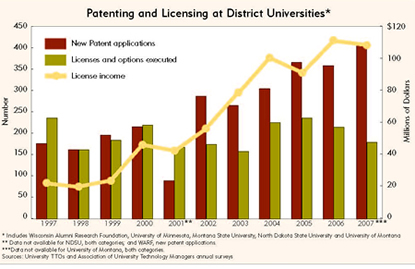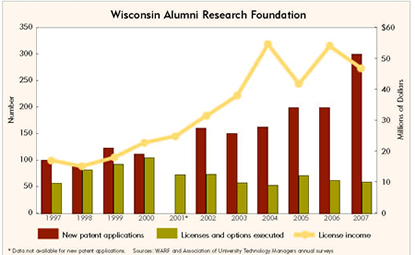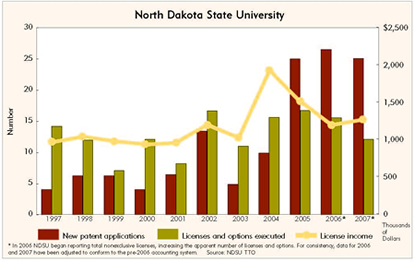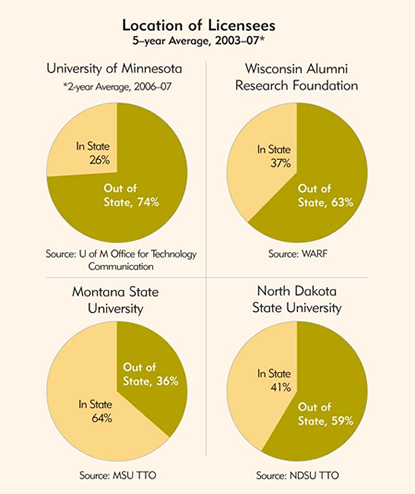The University of Minnesota plays in the big leagues of technology transfer. Over the years, the state's flagship institution of higher learning has patented hundreds of inventions by its researchers and licensed their use to companies across the continent and around the world. In 2006, the university pulled in $56.2 million in licensing fees and royalties, placing it fourth among U.S. universities ranked by licensing income.
But for all its success, the university believes that it can do even better at converting scientific discovery into intellectual property that can be patented and licensed to private enterprise. Over the past two years, the university has revamped its tech transfer operations in a bid to boost launch more startup firms.
The university's research arm wants to bring in more revenue from industry to make up for anticipated reductions in federal research funding. And state government and business groups have urged the university to strive harder to deliver the output of university labs to the marketplace. "Obviously the state expects a lot from us, our corporate partners felt that we could do a better job, and we ourselves felt we could do a better job," said R. Timothy Mulcahy, the university's vice president for research.
Since 2006, Mulcahy, recruited from the University of Wisconsin-Madison (an archrival in tech transfer), has reorganized the university's tech transfer operation and focused it on patenting and licensing inventions with the best chance of commercial success. "Technology strategy managers" work with researchers to assess discoveries, then hand off the most promising ones to other staffers, who market them aggressively to potential licensees. An expanded entrepreneurial program aims to increase the number of new companies launched from the university by providing mentoring and financial assistance to licensed startups.
The U of M isn't the only research institution in the Ninth District devoting significant resources to tech transfer, specifically patenting and licensing activities carried out by tech transfer offices, or TTOs. The Wisconsin Alumni Research Foundation (WARF), a nonprofit organization that serves as UW-Madison's tech transfer arm, has increased its patenting and licensing staff from 30 to 40 in the past five years. (Madison lies outside the district, but Wisconsin's top research institution exerts its influence throughout the state and beyond.)
Likewise, much smaller research universities have expanded their TTOs or taken steps to increase their licensing output in recent years. Montana State University (MSU) in Bozeman has doubled its patenting and licensing staff to four since 2003, when the university ended an outsourcing arrangement and established an internal TTO. South Dakota State University (SDSU) in Brookings plans to open a TTO this year.
This intense interest in tech transfer by district universities is part of a national trend toward increased patenting and licensing of academic research in the past 20 years.
The pressure to commercialize stems partly from a law that encourages universities to make discoveries resulting from taxpayer-funded research available to industry in order to foster prosperity and improve the lives of all Americans. Universities also see the marketing of academic innovation as a driver of regional and local economic development, the high-tech path to wealth creation and job growth.
But an examination of university patenting and licensing in the district suggests that this entrenched, increasingly popular model of tech transfer isn't as sharp a spur to technological progress and regional economic development as universities and their stakeholders believe. There's scant evidence that university licensing has resulted in greater technological advances than would have occurred if university discoveries had been made freely available to companies through published research. Licensing, while a lucrative enterprise for some institutions, has limited impact on regional and local economies, because most of the licenses issued by district universities go to firms outside their home states. And TTOs aren't very good at launching startups, key generators of innovation and growth in the technology sector.
This doesn't mean that academic research has no effect on technological progress, the national economy or regional competitiveness. A stream of inventions based on university discoveries over the past century—CT scanning, taconite processing, the Internet—testifies to the immense scientific and economic impact of university research. But licensing isn't the only way for businesses to tap into the wellspring of basic research flowing from university labs, and it's probably not the best way.
The high-profile activities of TTOs have "led to the assumption that tech transfer means licensing of university intellectual property," said Richard Lester, director of the Industrial Performance Center, a think tank at the Massachusetts Institute of Technology (MIT) that studies trends in industry. "It doesn't. It partly means that, but it means a lot of other things too."
From lab to market
Unlike General Mills or 3M, a university can't take new technologies directly from the lab to the marketplace. To convert the discoveries of researchers into marketable products, it must make them available to companies with the interest and means to invest in them further and put them on the market. Since the mid 1980s, more and more universities have turned to patenting and licensing to accomplish this transfer of technological know-how.
The Bayh-Dole Act of 1980 created a uniform policy for allowing universities to claim legal rights to inventions resulting from federally funded research and license their use to firms. The purpose of the law, passed by Congress at a time of concern about U.S. global competitiveness, was to ensure that inventions paid for with public funds were commercialized not only to boost business, but also to promote the general welfare. Advances in medicine, information technology, agriculture and other fields benefit private firms that profit from increased sales; but the public benefits as well from economic growth and enhanced quality of life.
In the tech transfer system that Bayh-Dole codified, the mechanism that transforms lab breakthroughs into market value is the licensing of intellectual property. Universities have a financial incentive to patent discoveries and license their use to companies in return for a cut of future sales.
The bulk of university licenses issued to companies are exclusive, giving only one company the right to profit from a patent. The reasoning behind this exclusivity—contested by many economists—is that without it firms would not invest in costly further development of early-stage university inventions. Introducing a new drug can cost over $1 billion in research and development.
"When you make something publicly available, you almost ensure that it will not be commercialized," said Jay Schrankler, executive director of the U of M's Office for Technology Commercialization (OTC). "If everyone has access to the same technology, who will commercialize it?
University inventions follow a fairly standard path toward commercialization, often running into diversions and dead ends. Most institutions require faculty, students and staff to disclose their discoveries to the TTO, which handles the process of laying claim to an invention on behalf of the university and—if the opportunity arises—licensing it to a company. Nationwide, about one in four disclosures results in a university patent. (Some inventions, such as software and medical protocols, are copyrighted rather than patented.) Instead of committing to a license, a firm may take out an option on the technology that provides for an evaluation period.
In a common scenario, TTO staffers try to identify and negotiate with a company willing to license the technology before applying for a patent, which can cost tens of thousands of dollars in filing and attorney's fees. If the TTO can't work out a deal with an established firm—or if the inventor burns with entrepreneurial zeal—it may lend a hand in forming a new company to license the discovery. Often the university takes an equity position in the startup.
Commercially successful licenses yield royalties that are split between the inventor and various units of the university. Faculty, staff or student inventors at the U of M receive one-third of net royalty revenue after TTO expenses. At MSU, the inventor's cut is half of net revenues; WARF pays inventors 20 percent of gross royalties. Depending on university policy, the balance can be distributed in any number of ways among the graduate school and the inventor's academic department and college to fund research and student support.
Go forth and license
Since the 1990s, academic patenting and licensing has surged across the country. According to data compiled by the Association of University Technology Managers (AUTM), between 1997 and 2006, the number of patent applications filed annually by U.S. universities more than tripled, and the number of licenses and options executed increased 155 percent.
A survey of the district's research universities shows that they too have increased their patenting activity over the past decade. The aggregate number of new patent applications by the schools more than doubled between 1997 and 2006, although this jump in patent filings hasn't resulted in a commensurate increase in licensing output. Total licensing revenue has mushroomed (see chart).

A major impetus for this heightened tech transfer activity—aside from the desire to draw upon an alternative source of research funding—is the conviction that patenting and licensing by universities contributes to economic growth through technology creation. Licensing discoveries to industry is seen as benefiting the national economy and having an even greater salutary effect on the economy of a university's "home" state or city.
Made available to the private sector through licensing to startups or established firms, the U of M's research has a "differential impact" regionally, Mulcahy said, strengthening and diversifying industry through technological innovation. Many business and community leaders share this view of university licensing to firms as a boon to state and local economies. One influential voice that urged Mulcahy to upgrade the U of M's tech transfer programs was the Itasca Project, a group of Twin Cities CEOs and civic leaders dedicated to economic progress in the metro area.
So how are district universities doing in meeting the goals of tech transfer—the first, the explicit intent of Bayh-Dole and the second, an implicit expectation by universities and their sponsors? How well do TTOs disperse the fruits of university research for the public good, and to what extent does licensing contribute to the economic growth of the region and individual communities?
The answers to these questions depend on how you measure performance.
Heavyweights and lightweights
One way to measure success in tech transfer is by counting patents, licenses and licensing revenue. By that yardstick, some research institutions in the district score high against national benchmarks in commercializing their discoveries. Others are much less active in patenting and licensing, but doing quite well considering the size of their research budgets.
The U of M and UW-Madison are the district's tech transfer heavyweights, befitting their ranking in the top 10 of U.S. research universities based on annual research expenditures. Generally speaking, the higher a university's research expenditures, the more disclosures, patents and licenses it produces. The U of M spent $595 million on research in 2006, according to the National Science Foundation. Its border rival spent $832 million that year, second only to Johns Hopkins University.
While neither institution can match the patenting and licensing output of technology powerhouses such as MIT (121 license and option agreements in 2006) and the University of California System, their performance is on par with similarly sized public research universities. They account for the lion's share of patenting and licensing activity in the district, although their individual production fluctuates from year to year (see charts).


WARF applied for 299 patents last year and has executed an average of 70 commercial licenses and options annually since 2002. The U of M's OTC filed 51 patent applications in 2007 and has averaged 80 licenses and options annually over the past six years.
The district's heavy hitters also excel at earning licensing revenue, seen by many university administrators as a crucial source of research funding in an era of slackening government support. University licensing income tends to grow over time, and WARF and the U of M are old hands at tech transfer. (WARF, the nation's oldest tech transfer organization, was established in 1925.) In this decade, annual licensing income reported by both schools has steadily risen along with the cumulative total of active licenses. WARF licenses earned $46.7 million in licensing revenue in fiscal 2007, a 45 percent increase since 2002. The U of M's $63.5 million in licensing revenues last year more than doubled its 2002 income figure.
Each university's share of licensing revenues far exceeds its tech transfer operating costs. The OTC's budget was $6 million last year—less than 10 percent of the U of M's gross licensing revenue. "If you looked at this as a [profit and loss statement], you would think it was the most incredible thing you've ever seen," Schrankler said. Compared with the district leaders, MSU and North Dakota State University in Fargo are bantamweights in the tech transfer game. MSU filed 39 patent applications and completed 34 license and option agreements last year. NDSU made 25 new patent applications and executed roughly half that number of licenses. The size of the two universities' research budgets explains the disparity; both conducted just over $100 million in research in 2006, about one-sixth of the U of M's research expenditures.
But the licensing volume of the smaller schools is equal to or higher than that of universities around the country with comparable research budgets, and that output is increasing. MSU's 2007 license production represents a 62 percent increase in four years. "I think we're right in the flow of things," said Rebecca Mahurin, director of the university's TTO. "We've set a record for license and option agreements every year since we've had it back in house." Patent and licensing activity at NDSU has been up and down since the school founded its TTO in 1995, but in the past four years, it has trended upward.


Like many small research universities that have gotten involved in tech transfer relatively recently, MSU and NDSU lose money on patenting and licensing; neither school generates enough licensing revenue to pay its TTO's expenses. In Mahurin's office, $220,000 in licensing revenue last year didn't cover patenting costs, let alone salaries, marketing and administrative overhead.
Other research universities in the district have sparse track records in tech transfer. They have small research budgets and lack either medical or engineering schools that typically generate a lot of patents and licenses. SDSU, the University of South Dakota in Vermillion and the University of Montana in Missoula have each executed fewer than five licenses annually this decade. (No data were available on patenting and licensing at the University of North Dakota in Grand Forks.)
Neither SDSU nor USD has a TTO, but both want to get more involved in patenting and licensing. In March, SDSU Vice President for Research Kevin Kephart was looking for a director for the university's new TTO, which he hoped could begin operations this spring.
On the market or on the shelf?
Patenting and licensing statistics, closely watched by university TTO directors and research chiefs, permit quantitative comparisons among tech transfer programs—who's topping the charts in patent applications and revenue earned, who's licensing above or below their weight class in research expenditures. But these metrics don't indicate how well universities are carrying out the primary mission of tech transfer: getting inventions into the marketplace for the public good as well as for private gain. Nor do they tell the whole story about the role of academic licensing in regional and local economic development.
"I think it's a mistake to look at overall patenting and licensing numbers and use those as a proxy for the value of technology transfer," said Bhaven Sampat, an economist at Columbia University who has studied tech transfer by universities.
The national surge in academic patenting and licensing over the past 15 years has coincided with an increased flow of technology from universities to corporate labs. Various studies have shown that the proportion of industry patents that cite a university patent as an inventive source has increased significantly since the 1980s.
But such studies don't reveal how many of the cited university patents were licensed to a company. And just because a firm takes out a license on a university invention doesn't mean that it will lead to a new marketable product or service. Some technologies are destined to sit on the shelf, and this is particularly true of early-stage university discoveries that require further research and development investment to become commercially viable. A 2001 study of tech transfer at major universities found that only 12 percent of university inventions were ready for commercial use when initially licensed.
Reliable data are scarce on long-term economic outcomes of academic patenting and licensing—how tech transfer activity translates into new products, increased company sales, bigger payrolls and rising incomes.
It's standard practice to require licensees to report on progress toward commercialization; in some cases, a firm must hit specified development milestones in order to maintain its license. But as a rule TTOs don't track the aggregate performance of their license portfolios—what proportion of licenses has achieved a measure of commercial success five, 10 or 15 years after licensing. At the U of M, where such followup has long been lacking, Schrankler has instituted a monitoring and auditing process for licensing.
High licensing revenue isn't an indicator of market penetration, either, because at many research universities the bulk of licensing income comes from a handful of "blockbuster," lucrative licenses. The rainmaker at the U of M is Ziagen, an HIV treatment licensed to GlaxoSmithKline Inc. Royalties paid on drug sales since 1999 bring in about $45 million annually, 70 percent of total university licensing income. WARF doesn't disclose revenue figures for individual licenses, but Managing Director Carl Gulbrandsen said that Zemplar, a synthetic form of vitamin D, is the foundation's biggest moneymaker, earning "tens of millions" of dollars annually in royalties.
A telling revenue statistic: Less than 1 percent of active licenses held by U.S. universities in 2001 yielded $1 million or more in annual revenue, according to AUTM. The vast majority of licensed inventions gain little traction in the market.
Without solid data on the market impact of tech transfer, it's impossible to say whether patenting and licensing has likely resulted in more commercialization than would have occurred if university discoveries had entered the public domain through graduate education, articles in academic journals, conferences and other traditional channels for disseminating knowledge.
Sampat, among other economists, rejects the notion voiced by Schrankler that university inventions must be licensed exclusively if they are to stand a chance of being commercialized. He said that this idea, the justification for university licensing under Bayh-Dole, stems from the pharmaceutical industry, in which new chemical compounds often have narrow and obvious applications in medicine. Exclusive licensing may be called for to keep competitors at bay while a company makes the necessary investment to refine the compound and steer it through clinical trials.
But in other industries—electronics and information technology, for example—a university discovery may lead to different lines of industry research, each with the potential to yield an array of patentable processes and products. In such instances, Sampat said, granting one firm sole use of an invention may hinder, rather than spur, technological progress. "The Bayh-Dole model may work for embryonic pharmaceuticals, but the whole world is not embryonic pharmaceuticals," he said.
I'll take that to go
Gulbrandsen is well aware of the political value of licensing to Wisconsin companies. Licensing to state firms shows lawmakers in Madison that the university is doing what it's supposed to as part of its land-grant mission—promote technological and economic progress in the state by sharing its knowledge with local industry. That fosters goodwill at the Legislature, he said, helping to garner support for day-to-day operations. "This is a state university, and if we were licensing all of the technology out of state, that ultimately would damage the image of the university when dealing with the Legislature at budget time."
But this perception of technology licensing as an engine of regional economic development is overblown, and not just at UW-Madison. The benefit of university licensing to regional and local economies in the district is less than that implied by licensing totals, because the bulk of licenses go to companies outside each school's home state (see charts). Last year, 62 percent of licenses and options executed by WARF went to firms headquartered outside Wisconsin. (The five-year average is 63 percent.) Two-thirds of U of M licensees in 2007 were based outside Minnesota, and NDSU's out-of-state percentage has averaged 59 percent in recent years.

The only district university with an active TTO that regularly executes more than half of its licensing agreements with in-state companies is MSU; last year, 53 percent of its licensees were Montana firms.
Why do the majority of licenses granted by district universities go to firms outside the school's home state? Schrankler of the U of M cites the "massive diversity" of intellectual property at the university eligible for licensing. Most in-state licenses are for medical devices, new chemical compounds and discoveries in biology and food science—all strengths of Minnesota industry. Finding a local niche for other types of inventions is more difficult, Schrankler said. New drugs, for example, are much more likely to be licensed by large pharmaceutical companies on the East Coast.
Dale Zetocha, director of NDSU's TTO, has his work cut out licensing any technology that doesn't go in the ground to in-state firms. Over 80 percent of NDSU license and option agreements with North Dakota firms are for agricultural innovations—novel varieties of wheat and barley or new herbicides. In a state with little high-tech industry, licenses for software, electronics, advanced polymer coatings and other non-ag inventions often go begging. "For some technologies there may not be a particular firm [in the state] that would have the capabilities to license that type of technology," Zetocha said. "Sometimes you have to look around the country to try to find any kind of company that might be a good fit."
MSU's relatively high proportion of in-state licensing may be due to the presence of more than 50 high-tech firms in Bozeman, including several laser optics firms that have benefited from the university's cutting-edge research in electro-optics. About a third of the area's high-tech firms hold active MSU licenses, Mahurin said.
Some licenses go to out-of-state firms with local manufacturing or sales facilities (WARF licensee General Electric operates a health care division in the Milwaukee area). Nevertheless, when companies outside the region leverage university technology, the economic benefits of that technology—assuming it reaches the marketplace—are dispersed. Some "knowledge spillovers" trickle down to the university's home state and city, but not as much as would accrue if locally owned firms made use of those licenses.
Another factor lessening the impact of licensing on state and local economies is universities' modest success at starting new companies to exploit licensed technology. Startups are crucial to the development of local high-tech economies because they create new wealth and employment that increase exponentially as young companies grow and spin off more startups. But the number of licensed startups spawned annually by TTOs is low compared with the number of unlicensed startups that are either affiliated with a research university in some other way or have no academic connection at all (see "The few, the risky.").
Costs vs. benefits
All this is not to say that patenting and licensing by TTOs hasn't contributed to the flow of innovation from universities to industry. It's likely that some drugs, medical devices and other products wouldn't have reached the market without the intellectual property protection afforded their developers by exclusive licensing. It's also possible that diligent marketing by TTOs has helped to push worthy technologies into the marketplace that otherwise would have died on the vine.
But there's ample evidence that what many universities view as the primary mode of technology transfer is not the most important pathway taken by university discoveries en route to industry labs and commercial success. Alternative channels prized by businesses themselves include published research, university-industry cooperative projects and learning that students transfer to the workplace upon graduation (see "Old-fashioned tech transfer,").
The limitations of licensing as a driver of U.S. technological innovation and regional and local economic growth puts the onus upon district universities to carefully weigh the costs and benefits of this approach to technology transfer. Devoting resources to direct commercialization leaves fewer resources available for other university functions, including basic research and education.
Licensing technology may be profitable at some universities, supplementing government support for research. (Last year, U of M licensing revenue applied to research amounted to about 7 percent of all research funding from external sources.) But it's debatable whether such activity serves the original purpose of Bayh-Dole or significantly boosts state and local economies. There's the risk that the pursuit of more licensing revenue to fund research can become an end in itself, impeding rather than facilitating the flow of ideas between campus and industry labs.
Most TTO managers downplay generating income as a goal of their programs. "We certainly want to get good money for our technology, but our more important issue is to see that the technology gets used," said Gulbrandsen of WARF. Yet biotech firms have criticized the organization for charging high licensing fees for the use of its stem cell patents, thereby discouraging further research.
Assessing costs and benefits is especially called for at universities such as MSU and NDSU that currently lose money on their tech transfer operations. These programs may become self-supporting as the number of active, revenue-producing licenses in their portfolios increases. Or they may continue to be financial sinks.
Sustaining losses may be justified if piping intellectual fuel to technology companies stimulates regional and local economic growth. But as NDSU has found, licensing discoveries in your own backyard can be a tall order in small markets without large concentrations of industry. And university licensing is rarely the main factor in the development of local high-tech "clusters"—concentrations of firms in related industries. An important ingredient of Bozeman's success as a technology mini-hub is its mountain setting that has attracted entrepreneurs who have founded companies with or without an MSU license.
Lester of MIT advises universities to adapt their tech transfer strategies to the economic realities of their home states or communities. Licensing university inventions may indeed promote growth in state and local economies if sufficient demand exists for those nascent technologies. If not, a better approach might be to give technology companies seeking to improve their processes and launch new products what they've always sought from research universities: smart graduates and open access to knowledge. In one market, a university may focus on developing continuing education and technical assistance programs; in another, technology conferences and collaborative research projects.
"In any economic environment I would urge a broader view of the university's role in the economy than just patenting and licensing," Lester said.





